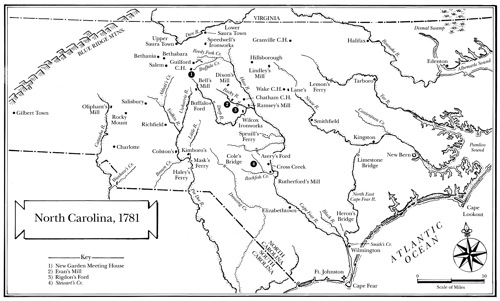Enclosure: Major General Nathanael Greene to Samuel Huntington, 16 March 1781
ENCLOSURE
Major General Nathanael Greene to Samuel Huntington
Camp at the Iron Works, 10 Miles from
Gilford Court House, March 16th 1781.
Sir
On the 10th I wrote to his Excellency Genl Washington from the high rock ford on the Haw River a copy of which I enclosed your Excellency that I had effected a junction with a Continental Regiment of Virginia 18 Months Men, and two considerable Bodies of Militia belonging to Virginia and North Carolina.1 After this junction finding that our force was much more respectable than it had been, and that there was a much greater probability of its declining than encreasing, and that there would be the greatest difficulty in subsisting it long in the Field in this exhausted Country, I took the resolution of attacking the Enemy without loss of time, and made the necessary disposition accordingly. Being persuaded that if we were successful it would prove ruinous to the Enemy, and if otherwise it would only prove a partial evil to us.
The Army marched from the high rock ford on the 12th, and on the 14th arrived at Gilford. The Enemy lay at the Quaker Meeting House on deep River, 8 Miles from our Camp.2 On the Morning of the 15th our reconnoitering parties reported the Enemy advancing on the great Salisbury road. The Army was drawn up in three Lines. The front Line was composed of the North Carolina Militia under the command of Generals Butler and Eaton;3 the second Line of Virginia Militia commanded by Generals Stevens and Lawson forming two Brigades; the third Line consisting of two Brigades, one of Virginia, and one of Maryland continental Troops, commanded by General Huger and Colo. Williams. Lieutt Colo. Washington with the Dragoons belonging to the 1st and 3d Regiments, a detachment of Light Infantry composed of continental Troops and a Regiment of Rifle-men under Colo. Lynch formed a corps of observation for the security of our right Flank Lieutt Colo. Lee with his Legion, a detachment of Light Infantry, and a Corps of Rifle-men under Colo. Campbell form’d a Corps of observation for the security of our left flank.4
The greater part of this Country is a Wilderness with a few cleared fields interspersed here and there. The Army was drawn up upon a large Hill of ground surrounded by other Hills, the greater part of which was covered with Timber and thick under brush. The front Line was posted just in the edge of the Woods and the back of a fence which run paralel with the Line, with an open field directly in their front. The second Line was in the Woods about 300 Yards in the rear of the first, and the continental troops about 300 Yards in the rear of the second, with a double front, as the Hill drew to a point where they were posted and on the right and left were two old fields.
In this position we waited the approach of the Enemy, having previously sent off the Baggage to this place appointed to rendezvous at in case of a defeat. Lieutt Colo. Lee with his Legion, his Infantry, and part of his Rifle-men met the Enemy on their advance, and had a very severe skirmish with Lieutt Colo. Tarlton, in which the Enemy suffered greatly. Captain Armstrong charged the British Legion and cut down near thirty of their Dragoons; but as the Enemy reinforced their advanced party, Lieutt Colo. Lee was obliged to retire and take his position in the line.5
The Action commenced by a cannonade which lasted about twenty minutes, when the Enemy advanced in three Columns, the Hessians on the right, the Guards in the center, and Lieutt Colo. Websters Brigade on the left. The whole moved through the old fields to attack the North Carolina Brigades who waited the attack untill the Enemy got within about one hundred and forty Yards, when part of them began a fire, but a considerable part left the ground without firing at all; some fired once and some twice, and none more, except a part of a Battalion of General Eatons Brigade. The General and field Officers did all they could to induce the Men to stand their ground, but neither the advantages of the position, nor any other consideration could induce them to stay. They left the ground and many of them threw away their Arms. General Stevens & General Lawson and the field Officers of those Brigades were more successful in their exertions. The Virginia Militia gave the Enemy a warm reception, and kept up a heavy fire for a long time, but being beat back the action became general almost every where. The Corps of observation under Washington and Lee were warmly engaged and did great execution. In ⟨a⟩ word the conflict was long and severe, and the Enemy only gained their point by superior discipline. They having broken the 2d Maryland Regiment, and turned our left flank and got

Map 2. The British won a Pyrrhic victory at Guilford Courthouse, where Cornwallis forced Greene from the field but suffered crippling losses that would alter his plans. (Illustrated by Rick Britton. Copyright Rick Britton 2022)
General Huger was the last that were engaged and gave the Enemy a check. We retreated in good order to the reedy fork river, and crossed at the ford about three miles from the field of Action, and there halted and drew up the Troops untill we collected most of our Stragglers.6
We lost our Artillery 4 pieces and two Ammunition Waggons, the greater part of the Horses being killed before the retreat began and it being impossible to move the pieces but along the great Road. After collecting our Stragglers we retired to this Camp 10 miles distant from Gilford.
From the best information I can get, the Enemies loss is very great, not less in killed and wounded than six hundred Men, besides some few Prisoners that we brought off.7
Inclosed I send your Excellency a return of our killed wounded, and missing. Most of the latter have gone home as is but too customary with the Militia after an Action. I canno⟨t⟩ learn that the Enemy have got any considerable numb⟨er⟩ of Prisoners.8 Our Men are in good spirits, and in perfect readiness for another field Day. I only lament the loss of several valuable Officers who were killed and wounded in the Action. Among the latter is Genl Stevens shot through the Thigh; and Genl Huger in the hand and among the former is Major Anderson of the Maryland line.
The firmness of the Officers and Soldiers during the whole Campaign has been almost unparalleled. Amidst innumerable difficulties they have discovered a degree of magnanimity and fortitude that will forever add a luster to their military reputation. I have the honor to be, with very great respect and esteem, Your Excellencys most obedient and most humble servt
Nath. Greene
Copy, DLC:GW; copy, NjP: De Coppet Collection. For a draft that appears to have been written with GW as the intended recipient, see NjP: De Coppet Collection. For the LS sent to Huntington, see DNA:PCC, item 155. Congress read Greene’s letter on 31 March and referred it “to the Committee of Intelligence” (, 19:335).
For details of the Battle of Guilford Courthouse, see , 7:436–41, and , 79–169; see also , 460–71. For an account of the battle from the perspective of Greene’s opponent, Lt. Gen. Charles Cornwallis, see his letter to George Germain of 17 March in , 20:90–93. Hessian major Carl Leopold Baurmeister wrote in his dispatch from New York City on 26 April: “I should now like to give a detailed account of the main action between Lord Cornwallis and General Greene at Guilford Court House, March 15th, but I am unable to obtain the necessary information. At General Clinton’s headquarters it is said that the victory was too dearly bought. I myself do not see anything extraordinary in it, for since we made no effort to smother the rebellion at the beginning, when it could have been done at a small cost, the rebels couldn’t help but become soldiers. Moreover, their trade is increasing every day.” Baurmeister then provided a narrative of the battle drawn largely from newspaper items (, 426–28, quote on 426).
1. See Greene to GW, 10 March. Greene’s letter to Huntington was of the same date (see , 7:423).
2. Cornwallis stated in his letter to Germain that on 13 March his army had encamped “at the Quaker Meeting between the forks of Deep River” (see source note above). This meetinghouse, known as the Deep River Meeting House, was located along the East Fork of the Deep River about twelve miles southwest of Guilford Courthouse. Some writers have mistaken this meetinghouse with the New Garden Meeting House, located about eight miles to the northeast. For a discussion of the error and its origin, see , 25–27.
3. Thomas Eaton (c.1739–1809) became colonel of the Bute County, N.C., militia in 1776. In November 1780, the state legislature named him a brigadier general. In addition to his commands in the militia, Eaton was elected to the North Carolina council of state in 1776, 1779, and 1784. For additional biographical details, see , 2:131.
4. A corps of observation is “a force employed in watching an army of the enemy, so as to be ready to check their movements” ().
5. For a detailed account of this running fight between the advanced corps of the two armies that gave Greene time to prepare his main army for battle, see , 52–56, and 29–46; see also , 272–75. Capt. James Armstrong commanded a troop of dragoons in Lt. Col. Henry Lee, Jr.’s legion.
6. Reedy Fork Creek rises about ten miles east of Salem, N.C., and flows northeast and then generally east for thirty miles, passing three miles north of Guilford Courthouse, until it empties into the Haw River.
7. In an enclosure with his letter to Germain, Cornwallis reported his casualties as 93 killed, 413 wounded, and 26 missing (see , 19:66–67; see also the source note above).
8. These casualty returns are in DNA:PCC, item 155. For other copies of these returns, see Greene to GW, 17 March, n.1.

![University of Virginia Press [link will open in a new window] University of Virginia Press](/lib/media/rotunda-white-on-blue.png)
